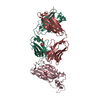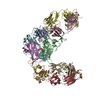[English] 日本語
 Yorodumi
Yorodumi- PDB-8f0i: Crystal structure of SARS-CoV-2 receptor binding domain in comple... -
+ Open data
Open data
- Basic information
Basic information
| Entry | Database: PDB / ID: 8f0i | |||||||||
|---|---|---|---|---|---|---|---|---|---|---|
| Title | Crystal structure of SARS-CoV-2 receptor binding domain in complex with human antibody COVA309-22 | |||||||||
 Components Components |
| |||||||||
 Keywords Keywords | VIRAL PROTEIN/IMMUNE SYSTEM / Antibody / SARS-CoV-2 / coronavirus / RBD / COVID-19 / IMMUNE SYSTEM / VIRAL PROTEIN-IMMUNE SYSTEM complex | |||||||||
| Function / homology |  Function and homology information Function and homology informationsymbiont-mediated disruption of host tissue / Maturation of spike protein / Translation of Structural Proteins / Virion Assembly and Release / host cell surface / host extracellular space / viral translation / symbiont-mediated-mediated suppression of host tetherin activity / Induction of Cell-Cell Fusion / structural constituent of virion ...symbiont-mediated disruption of host tissue / Maturation of spike protein / Translation of Structural Proteins / Virion Assembly and Release / host cell surface / host extracellular space / viral translation / symbiont-mediated-mediated suppression of host tetherin activity / Induction of Cell-Cell Fusion / structural constituent of virion / membrane fusion / entry receptor-mediated virion attachment to host cell / Attachment and Entry / host cell endoplasmic reticulum-Golgi intermediate compartment membrane / positive regulation of viral entry into host cell / receptor-mediated virion attachment to host cell / host cell surface receptor binding / symbiont-mediated suppression of host innate immune response / receptor ligand activity / endocytosis involved in viral entry into host cell / fusion of virus membrane with host plasma membrane / fusion of virus membrane with host endosome membrane / viral envelope / symbiont entry into host cell / virion attachment to host cell / SARS-CoV-2 activates/modulates innate and adaptive immune responses / host cell plasma membrane / virion membrane / identical protein binding / membrane / plasma membrane Similarity search - Function | |||||||||
| Biological species |   Homo sapiens (human) Homo sapiens (human) | |||||||||
| Method |  X-RAY DIFFRACTION / X-RAY DIFFRACTION /  SYNCHROTRON / SYNCHROTRON /  MOLECULAR REPLACEMENT / Resolution: 3.7 Å MOLECULAR REPLACEMENT / Resolution: 3.7 Å | |||||||||
 Authors Authors | Yuan, M. / Wilson, I.A. | |||||||||
| Funding support |  Netherlands, Netherlands,  United States, 2items United States, 2items
| |||||||||
 Citation Citation |  Journal: iScience / Year: 2023 Journal: iScience / Year: 2023Title: Broad SARS-CoV-2 neutralization by monoclonal and bispecific antibodies derived from a Gamma-infected individual. Authors: Denise Guerra / Tim Beaumont / Laura Radić / Gius Kerster / Karlijn van der Straten / Meng Yuan / Jonathan L Torres / Wen-Hsin Lee / Hejun Liu / Meliawati Poniman / Ilja Bontjer / Judith A ...Authors: Denise Guerra / Tim Beaumont / Laura Radić / Gius Kerster / Karlijn van der Straten / Meng Yuan / Jonathan L Torres / Wen-Hsin Lee / Hejun Liu / Meliawati Poniman / Ilja Bontjer / Judith A Burger / Mathieu Claireaux / Tom G Caniels / Jonne L Snitselaar / Tom P L Bijl / Sabine Kruijer / Gabriel Ozorowski / David Gideonse / Kwinten Sliepen / Andrew B Ward / Dirk Eggink / Godelieve J de Bree / Ian A Wilson / Rogier W Sanders / Marit J van Gils /   Abstract: The pandemic caused by severe acute respiratory syndrome coronavirus 2 (SARS-CoV-2) has remained a medical threat due to the evolution of multiple variants that acquire resistance to vaccines and ...The pandemic caused by severe acute respiratory syndrome coronavirus 2 (SARS-CoV-2) has remained a medical threat due to the evolution of multiple variants that acquire resistance to vaccines and prior infection. Therefore, it is imperative to discover monoclonal antibodies (mAbs) that neutralize a broad range of SARS-CoV-2 variants. A stabilized spike glycoprotein was used to enrich antigen-specific B cells from an individual with a primary Gamma variant infection. Five mAbs selected from those B cells showed considerable neutralizing potency against multiple variants, with COVA309-35 being the most potent against the autologous virus, as well as Omicron BA.1 and BA.2, and COVA309-22 having binding and neutralization activity against Omicron BA.4/5, BQ.1.1, and XBB.1. When combining the COVA309 mAbs as cocktails or bispecific antibodies, the breadth and potency were improved. In addition, the mechanism of cross-neutralization of the COVA309 mAbs was elucidated by structural analysis. Altogether these data indicate that a Gamma-infected individual can develop broadly neutralizing antibodies. #1:  Journal: Biorxiv / Year: 2022 Journal: Biorxiv / Year: 2022Title: Broad SARS-CoV-2 Neutralization by Monoclonal and Bispecific Antibodies Derived from a Gamma-infected Individual Authors: Guerra, D. / Beaumont, T. / Radic, L. / Kerster, G. / van der Straten, K. / Yuan, M. / Torres, J. / Lee, W.H. / Liu, H. / Poniman, M. / Bontjer, I. / Burger, J.A. / Claireaux, M. / Caniels, ...Authors: Guerra, D. / Beaumont, T. / Radic, L. / Kerster, G. / van der Straten, K. / Yuan, M. / Torres, J. / Lee, W.H. / Liu, H. / Poniman, M. / Bontjer, I. / Burger, J.A. / Claireaux, M. / Caniels, T.G. / Snitselaar, J.L. / Bijl, T.P.L. / Kruijer, S. / Ozorowski, G. / Gideonse, D. / Sliepen, K. / Ward, A.B. / Eggink, D. / de Bree, G.J. / Wilson, I.A. / Sanders, R.W. / van Gils, M.J. | |||||||||
| History |
|
- Structure visualization
Structure visualization
| Structure viewer | Molecule:  Molmil Molmil Jmol/JSmol Jmol/JSmol |
|---|
- Downloads & links
Downloads & links
- Download
Download
| PDBx/mmCIF format |  8f0i.cif.gz 8f0i.cif.gz | 366.2 KB | Display |  PDBx/mmCIF format PDBx/mmCIF format |
|---|---|---|---|---|
| PDB format |  pdb8f0i.ent.gz pdb8f0i.ent.gz | 297.3 KB | Display |  PDB format PDB format |
| PDBx/mmJSON format |  8f0i.json.gz 8f0i.json.gz | Tree view |  PDBx/mmJSON format PDBx/mmJSON format | |
| Others |  Other downloads Other downloads |
-Validation report
| Summary document |  8f0i_validation.pdf.gz 8f0i_validation.pdf.gz | 510.8 KB | Display |  wwPDB validaton report wwPDB validaton report |
|---|---|---|---|---|
| Full document |  8f0i_full_validation.pdf.gz 8f0i_full_validation.pdf.gz | 528.3 KB | Display | |
| Data in XML |  8f0i_validation.xml.gz 8f0i_validation.xml.gz | 63 KB | Display | |
| Data in CIF |  8f0i_validation.cif.gz 8f0i_validation.cif.gz | 85 KB | Display | |
| Arichive directory |  https://data.pdbj.org/pub/pdb/validation_reports/f0/8f0i https://data.pdbj.org/pub/pdb/validation_reports/f0/8f0i ftp://data.pdbj.org/pub/pdb/validation_reports/f0/8f0i ftp://data.pdbj.org/pub/pdb/validation_reports/f0/8f0i | HTTPS FTP |
-Related structure data
| Related structure data |  6w41S S: Starting model for refinement C: citing same article ( |
|---|---|
| Similar structure data | Similarity search - Function & homology  F&H Search F&H Search |
- Links
Links
- Assembly
Assembly
| Deposited unit | 
| ||||||||
|---|---|---|---|---|---|---|---|---|---|
| 1 | 
| ||||||||
| 2 | 
| ||||||||
| 3 | 
| ||||||||
| Unit cell |
|
- Components
Components
| #1: Protein | Mass: 23104.867 Da / Num. of mol.: 3 / Fragment: Receptor binding domain, UNP residues 333-530 Source method: isolated from a genetically manipulated source Source: (gene. exp.)  Production host:  Trichoplusia ni (cabbage looper) / References: UniProt: P0DTC2 Trichoplusia ni (cabbage looper) / References: UniProt: P0DTC2#2: Antibody | Mass: 23919.764 Da / Num. of mol.: 3 Source method: isolated from a genetically manipulated source Source: (gene. exp.)  Homo sapiens (human) / Production host: Homo sapiens (human) / Production host:  #3: Antibody | Mass: 23568.057 Da / Num. of mol.: 3 Source method: isolated from a genetically manipulated source Source: (gene. exp.)  Homo sapiens (human) / Production host: Homo sapiens (human) / Production host:  #4: Sugar | Has ligand of interest | N | Has protein modification | Y | |
|---|
-Experimental details
-Experiment
| Experiment | Method:  X-RAY DIFFRACTION / Number of used crystals: 1 X-RAY DIFFRACTION / Number of used crystals: 1 |
|---|
- Sample preparation
Sample preparation
| Crystal | Density Matthews: 2.37 Å3/Da / Density % sol: 48.16 % |
|---|---|
| Crystal grow | Temperature: 293.15 K / Method: vapor diffusion, sitting drop / pH: 6.5 Details: 0.1 M sodium cacodylate, pH 6.5, 0.2 M magnesium chloride, and 20% (w/v) polyethylene glycol 1000 |
-Data collection
| Diffraction | Mean temperature: 100 K / Serial crystal experiment: N | |||||||||||||||||||||||||||||||||||||||||||||||||||||||||||||||||||||||||||||||||||||||||||||||||||||||||||||||||||||||||||||||||||||||||||||||||||
|---|---|---|---|---|---|---|---|---|---|---|---|---|---|---|---|---|---|---|---|---|---|---|---|---|---|---|---|---|---|---|---|---|---|---|---|---|---|---|---|---|---|---|---|---|---|---|---|---|---|---|---|---|---|---|---|---|---|---|---|---|---|---|---|---|---|---|---|---|---|---|---|---|---|---|---|---|---|---|---|---|---|---|---|---|---|---|---|---|---|---|---|---|---|---|---|---|---|---|---|---|---|---|---|---|---|---|---|---|---|---|---|---|---|---|---|---|---|---|---|---|---|---|---|---|---|---|---|---|---|---|---|---|---|---|---|---|---|---|---|---|---|---|---|---|---|---|---|---|
| Diffraction source | Source:  SYNCHROTRON / Site: SYNCHROTRON / Site:  SSRL SSRL  / Beamline: BL12-2 / Wavelength: 0.97946 Å / Beamline: BL12-2 / Wavelength: 0.97946 Å | |||||||||||||||||||||||||||||||||||||||||||||||||||||||||||||||||||||||||||||||||||||||||||||||||||||||||||||||||||||||||||||||||||||||||||||||||||
| Detector | Type: DECTRIS PILATUS 6M / Detector: PIXEL / Date: Jan 26, 2022 | |||||||||||||||||||||||||||||||||||||||||||||||||||||||||||||||||||||||||||||||||||||||||||||||||||||||||||||||||||||||||||||||||||||||||||||||||||
| Radiation | Protocol: SINGLE WAVELENGTH / Monochromatic (M) / Laue (L): M / Scattering type: x-ray | |||||||||||||||||||||||||||||||||||||||||||||||||||||||||||||||||||||||||||||||||||||||||||||||||||||||||||||||||||||||||||||||||||||||||||||||||||
| Radiation wavelength | Wavelength: 0.97946 Å / Relative weight: 1 | |||||||||||||||||||||||||||||||||||||||||||||||||||||||||||||||||||||||||||||||||||||||||||||||||||||||||||||||||||||||||||||||||||||||||||||||||||
| Reflection | Resolution: 3.7→50 Å / Num. obs: 41627 / % possible obs: 99.8 % / Redundancy: 6.7 % / Rmerge(I) obs: 0.955 / Χ2: 0.153 / Net I/σ(I): 1.9 / Num. measured all: 277783 | |||||||||||||||||||||||||||||||||||||||||||||||||||||||||||||||||||||||||||||||||||||||||||||||||||||||||||||||||||||||||||||||||||||||||||||||||||
| Reflection shell |
|
- Processing
Processing
| Software |
| |||||||||||||||||||||||||||||||||||||||||||||||||||||||||||||||
|---|---|---|---|---|---|---|---|---|---|---|---|---|---|---|---|---|---|---|---|---|---|---|---|---|---|---|---|---|---|---|---|---|---|---|---|---|---|---|---|---|---|---|---|---|---|---|---|---|---|---|---|---|---|---|---|---|---|---|---|---|---|---|---|---|
| Refinement | Method to determine structure:  MOLECULAR REPLACEMENT MOLECULAR REPLACEMENTStarting model: 6W41 Resolution: 3.7→47.25 Å / SU ML: 0.52 / Cross valid method: FREE R-VALUE / σ(F): 1.34 / Phase error: 26.45 / Stereochemistry target values: ML
| |||||||||||||||||||||||||||||||||||||||||||||||||||||||||||||||
| Solvent computation | Shrinkage radii: 0.9 Å / VDW probe radii: 1.11 Å / Solvent model: FLAT BULK SOLVENT MODEL | |||||||||||||||||||||||||||||||||||||||||||||||||||||||||||||||
| Refinement step | Cycle: LAST / Resolution: 3.7→47.25 Å
| |||||||||||||||||||||||||||||||||||||||||||||||||||||||||||||||
| Refine LS restraints |
| |||||||||||||||||||||||||||||||||||||||||||||||||||||||||||||||
| LS refinement shell |
|
 Movie
Movie Controller
Controller






 PDBj
PDBj






